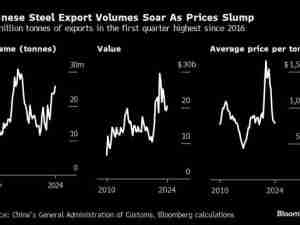China’s Factory Prices Give Global Inflation Unexpected Lift
By: | Sep 11 2017 at 12:01 AM | International Trade
Inflationary pressure emanating from the factory to the world is proving more resilient than economists have anticipated.
China’s producer-price inflation accelerated to 6.3 percent in August from a year earlier, exceeding all but one of 38 estimates in Bloomberg’s survey of economists. That data released Saturday followed 5.5 percent readings in the prior three months and was unexpected for analysts, who have been forecasting more moderation in pricing pressures.
The surprise strength gives support for global inflation spanning from metals to fuel and shows the effects of resilient domestic demand and reduced supplies of some commodities. China’s authorities have been closing mills and smelters to cut excessive industrial capacity and help curb pollution, in turn straining production of metals such as aluminum and steel.
“The key driver has likely come from the supply side,” such as production cuts in response to intensified environmental enforcement in recent months, Robin Xing, chief China economist at Morgan Stanley in Hong Kong, wrote in a note. The bank last week raised its 2017 PPI forecast to 5.5 percent from 4.5 percent, citing stricter anti-pollution measures.
Global metal prices soared last month as China’s demand held up on robust investment and construction amid government reforms that may crimp supplies. That market strength underpins worldwide inflation, and helps ease debt burdens on raw-material producers.
China’s environmental campaign has intensified this year. Inspections that began in Hebei, which surrounds Beijing and is the biggest steel-producing province, have been extended to several more cities and provinces and led to the closures of some businesses and factories.
Aluminum Corp. of China, the nation’s top state-owned smelter of the metal, pledged this month to cut capacity during the winter to curb emissions. Aluminum prices have has surged this year, making it one of the best-performing commodities, on expectations for supply cuts and resilient demand from property and infrastructure. That’s boosting producer inflation.
“While cyclical demand remained resilient, the ‘rationed’ output volume amid stricter environmental inspections may have led to stronger inflationary pressure in August,” Liu Wenqi, an analyst at China International Capital Corp. in Beijing, wrote in a report.
Another underpinning for better-than-expected factory prices comes from infrastructure investment, which is often used to buffer growth amid downward economic pressure. The share of spending used for road, rail and other infrastructure this year has surpassed levels during the global financial crisis, according to a Bloomberg Intelligence analysis.
That boost, however, may prove temporary, as government splurging turns to constraint later this year. Generous government spending to ensure the economy is humming nicely when the 19th Party Congress convenes in October means the fiscal pump is unlikely to kick up a notch as usual at year-end, which is when economists see growth moderating.
“August’s price data show China’s reflation story remains intact,” Tom Orlik, chief Asia economist at Bloomberg Intelligence in Beijing, wrote in a report Saturday. “The caveat is that reflation reflects more stimulus-boosted demand, and positive market sentiment, than it does efforts to close down excess supply – and is therefore subject to reversal.”
Data released Saturday also showed a pickup in the consumer price index, which exceeded estimates with a 1.8 percent increase after rising 1.4 percent in July. Prices rose from the prior month, affected mainly by increases for eggs and vegetables amid hot weather and rain, the National Bureau of Statistics said in a statement.
“The market has underestimated the inflationary pressure facing China’s economy, although the inflation is unlikely to surge in the foreseeable future,” said Zhou Hao, an economist at Commerzbank AG in Singapore. “There’s little hope China’s monetary policy could see some relaxation before the end of this year.”

